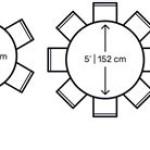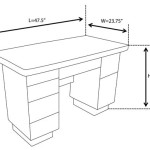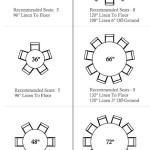Understanding Average Dining Table Length: A Comprehensive Guide
The dining table serves as a central gathering point in many homes, a place for meals, conversations, and shared experiences. Its size is critical, dictating how comfortably individuals can be seated and the overall flow of the dining space. Determining the appropriate dining table length involves careful consideration of several factors, including the number of regularly accommodated diners, available room dimensions, and desired aesthetic. Understanding average dining table lengths and the parameters influencing their selection is key to creating a functional and visually appealing dining area.
While there isn't a single, universally applicable "average," dining table lengths tend to fall within specific ranges based on the number of seats they accommodate. This article will explore those ranges, delve into the factors that contribute to optimal table length selection, and provide practical guidance for choosing the right size dining table for particular needs and spaces.
Key Point 1: Standard Dining Table Lengths by Seating Capacity
The length of a dining table is directly correlated to the number of people it can comfortably seat. Recognizing the standard dimensions associated with different seating capacities provides a foundational understanding for selecting the appropriate table size.
Dining Tables for 4 People: Often referred to as small dining tables, these usually range in length from 48 to 60 inches. This size is suitable for smaller dining rooms or kitchen nooks. Square tables designed for four people typically measure around 36 to 48 inches per side.
Dining Tables for 6 People: This is a common size for families and those who regularly host small gatherings. The standard length for a six-person rectangular dining table typically falls between 60 and 78 inches. Round tables intended for six people generally have a diameter of 48 to 60 inches.
Dining Tables for 8 People: For larger gatherings or families, an eight-person dining table is often the preferred choice. Expect a length of 78 to 96 inches for a rectangular table. Round tables designed for eight diners usually require a diameter of 60 to 72 inches.
Dining Tables for 10 or More People: These tables are often found in formal dining rooms or homes that frequently host larger events. The length for a ten-person rectangular dining table starts around 96 inches and can extend significantly longer depending on the desired spacing between diners. Round tables for this capacity generally have a diameter greater than 72 inches.
It's important to note that these dimensions offer general guidelines. The exact length requirements may vary based on the style of the table, the size of the chairs, and the preferred amount of personal space for each diner. For instance, armchairs generally require more space than armless chairs, impacting the overall table length requirement.
Key Point 2: Factors Influencing Dining Table Length Selection
Beyond the number of people needing to be seated, several other factors play a crucial role in determining the optimal dining table length. These factors relate to the available space, the desired aesthetic, and the functional needs of the space.
Room Dimensions: The available space is perhaps the most critical factor. Before selecting a dining table, the dimensions of the dining room or dining area should be accurately measured. A minimum of 36 inches of clearance space should be maintained between the table and any walls or furniture. This allows for comfortable movement around the table and prevents the room from feeling cramped. In smaller spaces, opting for a table with leaves that can be extended or retracted as needed can provide flexibility.
Table Shape: The shape of the dining table also affects the ideal length and seating capacity. Rectangular tables are a classic choice and efficient for seating multiple people in a relatively linear fashion. Round tables, on the other hand, encourage conversation and create a more intimate dining experience, but may take up more floor space. Square tables work well in smaller square-shaped rooms. Oval tables offer a softer, more elegant alternative to rectangular tables.
Chair Dimensions: The size and style of the dining chairs must be considered in conjunction with the table length. Wider chairs, especially those with arms, will require more space along the table's perimeter. When calculating the necessary table length, account for the width of each chair and the space needed for diners to sit comfortably. Allow at least 24 inches per diner to prevent overcrowding.
Dining Style and Function: The intended function of the dining table should also influence the selection process. If the table is primarily used for formal dinners, a larger table that allows ample space for serving dishes and place settings may be preferred. If the table is used for everyday meals or as a workspace, a smaller, more versatile table might be more suitable. Consider whether the table will also be used for activities such as board games or homework, which may require additional surface area.
Aesthetic Considerations: The dining table should complement the overall style and décor of the room. The table's length and proportions should be visually balanced with the size and features of the space. A larger table can serve as a focal point in a larger room, while a smaller table can help to create a more intimate and cozy atmosphere in a smaller space. The material and finish of the table should also be consistent with the overall design scheme.
Key Point 3: Measuring Your Space and Determining the Right Table Length
Accurately measuring the dining area is a crucial step in determining the appropriate dining table length. A systematic approach to measuring and planning will help to avoid costly mistakes and ensure a functional and aesthetically pleasing dining space.
Measure the Room: Begin by measuring the length and width of the dining room or dining area. Note any doorways, windows, or other architectural features that may impact the placement of the table. Sketch a rough floor plan of the room, indicating the dimensions and the location of any obstacles.
Determine Clearance Space: As previously mentioned, a minimum of 36 inches of clearance space should be maintained around the table. This allows diners to comfortably pull out their chairs and move around the table without bumping into walls or other furniture. In high-traffic areas, a clearance space of 42 to 48 inches may be preferable.
Calculate Maximum Table Size: Subtract the desired clearance space from the length and width of the room to determine the maximum dimensions of the dining table. For example, if the room is 12 feet wide (144 inches) and 14 feet long (168 inches), and a 36-inch clearance is desired on all sides, the maximum table width would be 72 inches (144 - 36 - 36) and the maximum table length would be 96 inches (168 - 36 - 36).
Consider Table Shape: The calculated maximum dimensions should be adjusted based on the desired table shape. For a rectangular table, the length and width should not exceed the calculated maximum dimensions. For a round table, the diameter should not exceed the smaller of the two calculated dimensions (width or length). For a square table, the side length should not exceed the smaller of the two calculated dimensions.
Account for Seating Capacity: Once the maximum table dimensions have been determined, verify that the selected size can comfortably accommodate the desired number of diners. Use the standard dining table length guidelines provided earlier in this article as a reference. Consider the style of the chairs and the desired amount of personal space when calculating the seating capacity.
Use Visual Aids: Before making a purchase, consider using visual aids to help visualize the table in the dining space. Use painter's tape to mark the outline of the table on the floor. This will provide a visual representation of the table's footprint and help to ensure that it fits comfortably in the room. Cardboard or fabric can also be used to simulate the height and bulk of the table.
By carefully considering the number of diners, room dimensions, table shape, and chair size, individuals can make an informed decision and select a dining table length that perfectly suits their needs and complements their dining space. Remember to prioritize functionality, aesthetics, and comfort to create a welcoming and enjoyable dining experience.
Ultimately, the "average" dining table length is a flexible concept, adaptable to individual circumstances. Knowledge of standard sizes coupled with meticulous space assessment empowers informed choices, resulting in a dining area that is both functional and visually harmonious.

Standard Dining Table Dimensions Sizes With 9 Detailed Diagrams Homenish Height

What Is The Ideal Dining Table And Chair Height

What Are Standard Table Heights

What Is The Ideal Dining Table And Chair Height

Dining Table Height Chair

What Are Standard Table Heights

What Is The Ideal Dining Table And Chair Height

How To Pick A Table Guide Including Dimensions

Average Size Of A Dining Room Tips For Choosing The Right Table

Dining Table Size Buildsearch
Related Posts








